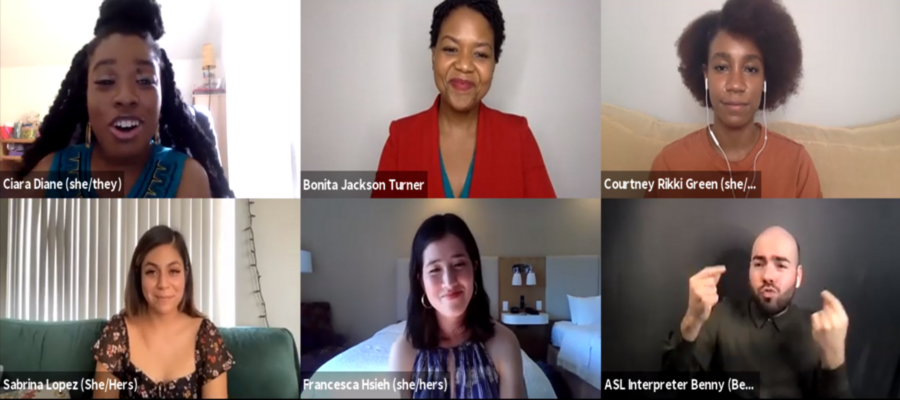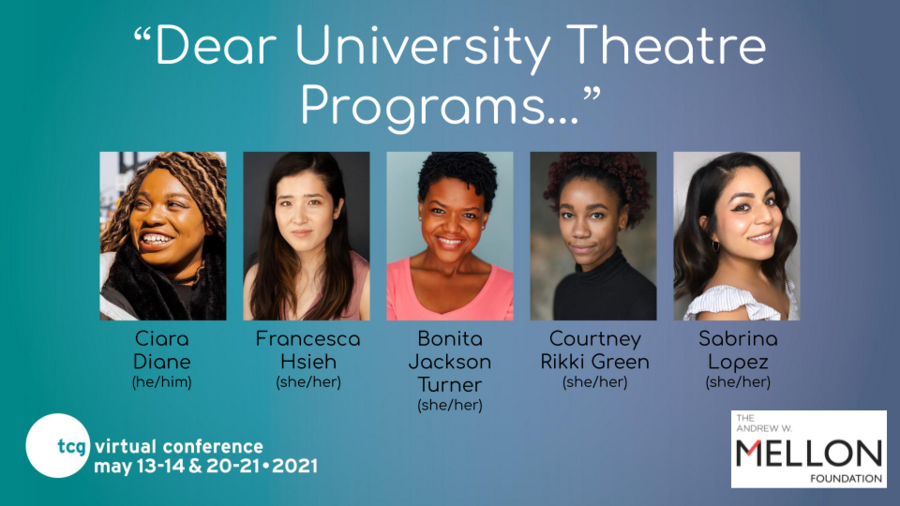This article is one of two we’re publishing today on anti-racism efforts within university theatre training programs. The other piece, about the unique role educators of color can play in such efforts, is here.
An entire school year has passed since several university theatre programs were met with public statements penned by their students and alumni about the racism and bias prevalent within their departments. Since then, many, including myself, have been eager to hear what effect these letters have had within these theatre programs. My chance came last month, when I had the honor of moderating a roundtable discussion with four Black, Indigenous, and people of color (BIPOC) student and alumni statement organizers at Theatre Communication Group’s virtual national conference. I was joined for this conversation by Bonita Jackson Turner (she/her), who graduated this spring from Florida State University/Asolo Conservatory; Courtney Rikki Green (she/her), an alumni of Syracuse University; Francesca Hsieh (she/her), who graduated this spring from the University of Utah; and Sabrina Lopez (she/her) a student at California State University, Fullerton.
As this roundtable served partly as a follow-up on the work of student and alumni organizers since I reported on their statements last year, I suppose this article should answer the lingering question from the first: So, did university theatre programs “take the note”? It depends on who you ask.
In contrast to the public nature of many of last year’s statements, much of the aftermath has played out in private. Many of the conversations between organizers and faculty are happening behind closed doors, making it difficult for those not involved to surmise whether student and alumni organizers are being listened to, what changes are actually being made, and how current students are impacted, if at all. This roundtable, then, set a unique stage where the curtain could be pulled back on some of these closed-door conversations and provide the opportunity for student and alumni organizers to share their experiences holding their theatre programs accountable.
Based on what the organizers had to say during the panel, there’s no doubt that something has shifted—if only in the way that university theatre programs who received letters are having to actually name or acknowledge that there is racism and/or racist practices within their departments. Some organizers said that directly after the release of their statements, a few faculty and staff members reached out personally to speak with them.
“We basically talked about our grievances and the problems we had had, the discrimination we faced,” said Hsieh during the panel, “and then also potential solutions and changes, and things we would like to see in the curriculum and in the structure of the department.”
Green also expressed that she and her fellow organizers’ statement was met with a certain level of validation from both faculty and others who read the letter. The call to action to Syracuse University gave its administration a deadline of 72 hours to respond, which faculty met by responding within 24 hours. In their response, they voiced support for what organizers had said, as well as affirming their own dedication to working with organizers to help achieve their demands.
“After our fourth meeting, we decided we weren’t going to have any more meetings with professors unless we had a facilitator present because of the emotional labor that was involved.”
But some university programs were less open to hearing the statements. “The way my program has operated over x amount of years has been, ‘We deal with things behind closed doors,’” Jackson Turner said. “So when the call to action came out, it was like an atomic bomb of melanin had rushed through the Sarasota streets claiming that we had been wronged.”
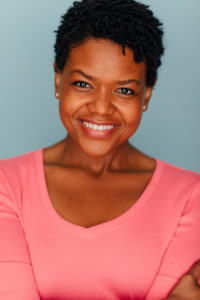
FSU/Asolo Conservatory’s theatre program is unique in that it has also had an intricate and longstanding partnership with Asolo Repertory Theatre for over 40 years. Jackson Turner shared that she and the four other Black students who wrote the letter received a lot of support from current students, alumni, and artists who previously worked with both FSU/Asolo Conservatory and Asolo Rep. But many in the Sarasota community, particularly white people, did not share the same sentiment. This was perhaps best exemplified when several participants in Asolo Rep’s student-sponsor program for FSU/Asolo Conservatory students opted to leave the program after the release of the students’ letter. Jackson Turner added after the roundtable that some saw her and her fellow organizers as ungrateful, even going so far as to tell them not to “bite the hand that feeds” them.
One commonality among the organizers gathered for the roundtable was a desire to break this “behind closed doors” mentality around instances of racism. This practice is especially problematic because of the inherent power imbalance among students and their professors and administrators. One way that some students were able to navigate this power imbalance was by employing a mediator or third party within these conversations.
“After our fourth meeting,” Hsieh said of conversations with University of Utah faculty, “we decided we weren’t going to have any more meetings with professors unless we had a facilitator present, because of the emotional labor that was involved. They were just becoming so taxing that they were no longer productive.”
Similarly, Jackson Turner and her fellow FSU student organizers refused to enter a space without someone from FSU or allies present for their own safety. Luckily, in some cases, these discussions were able to continue in a meaningful way.
Some faculty members do seem to be making earnest efforts to address racism within their departments. In a Backstage article on changes made in acting programs, faculty from various universities cited departmental changes that they’ve implemented since the release of the call to action statements. Some of these changes include shifts in their curriculum to include more diverse playwrights and acting pedagogy; the addition of faculty committees and/or student groups focused on equity, diversity, and inclusion; concentrated efforts to be more inclusive in their hiring processes; and the introduction of trainings, events, and conversations centered on diversity.
At the roundtable, organizers also spoke to some of the changes they’d seen within their theatre departments. One difference several of the organizers noted was a cultural shift to students feeling more empowered to demand accountability from their faculty, staff, and department as a whole. “I would say the biggest change is that the students are really stepping up and taking power, and making change happen where we’re not getting it,” said Lopez of what she’s experienced within CSUF’s theatre department.
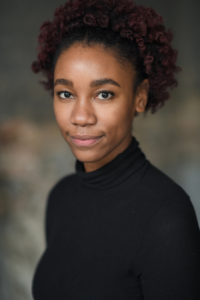
Green also mentioned that there are now open gatherings at Syracuse where students, with a student liaison present, can meet with faculty and discuss issues they’re having within the department. Syracuse in turn has started to address some of the demands in the call to action statement, including getting rid of the usage of “colorblind casting” in departmental communications, allowing all graduating seniors the option to participate in the annual showcase, and, most recently, issuing a formal apology from the university. There was also the addition of a designated faculty member in charge of addressing specific student issues, particularly racial bias or any kind of abuse that may be happening, and organizers were able to get a harmful professor, who reportedly “liked to say the N word,” investigated and put on leave.
Meanwhile, at the University of Utah, in addition to a newly formed Justice, Equity, Diversity, and Inclusion Committee, composed of student and faculty members, the department addressed one of the student’s demands by establishing an endowed scholarship. Conceived last fall, the scholarship was created “to benefit students from traditionally underrepresented communities who have demonstrated a commitment to increasing representation in theatre.” With an initial goal of raising $5,000, the program has currently raised $17,964 through crowdfunding.
At FSU/Asolo Conservatory, who hadn’t produced a play written by a Black playwright in over two decades until last fall, one key element to making change was the collaboration between the student organizers and FSU’s administrative staff. “The reason why I think we have had some strides throughout this year has been because Florida State University’s administration has been a constant presence,” shared Jackson Turner. “They actually have been a crucial element to the progress we have seen happen. And though we have a long way to go, dean James Frazier, the dean of FSU’s College of Fine Arts, and Brad Brock, director of the School of Theatre, have come in and been advocates for us.”
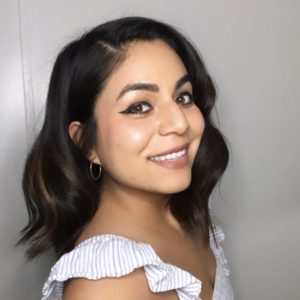
The level and efficacy of change varies from program to program. In Lopez’s case, she and her fellow organizers at California State University, Fullerton, still felt unheard after meeting with faculty. The work that has continued, she said, has been due to the efforts of students, who created Theatre Artists Union for Student Equity and Diversity (TAUSED) at CSUF, a resource for students experiencing harm, designed to facilitate conversations between those students and faculty members. Members of TAUSED primed themselves by doing their research on how to contact various incident reporting avenues, such as Title IX and human resources, and exploring what steps could be taken by students who’ve been harmed in the classroom.
Lopez noted that a diversity club had also been started by the department to work on policy changes. Though co-chaired by Lopez herself and composed of students, faculty, and staff, Lopez shared that the group has received some pushback from faculty and staff members who aren’t involved with it, and that they’re still awaiting a statement of diversity from departmental leaders.
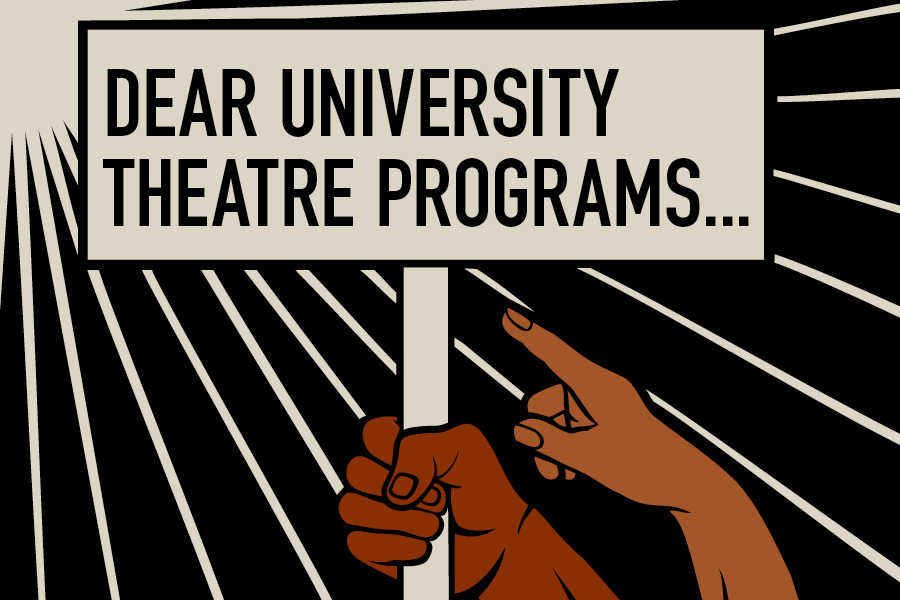
This experience touches on a larger issue also cited by the other organizers on the roundtable: the amount of labor placed on BIPOC student and alumni organizers. While the roundtable speakers had different examples to share, all mentioned how they’d been asked to provide solutions or answers to racism happening within the department. In Jackson Turner’s department, while an anti-racist action plan is currently in progress, she said that at an earlier point, the expectation seemed to be that the student organizers would write up the plan entirely themselves. Lopez shared that at her school, they wanted her and her fellow organizers to craft a video explaining to students how they could go through the university to report racism in the department—before she even knew how to do so herself.
The labor being expected of these organizers also extends to the amount of emotional labor it takes to even have these conversations.
“Having to meet with your professors and relive your trauma just for them to understand what they’ve done to you and to students in the past [is something] we had to do over and over again,” Lopez remarked. “To have to sit there and convince tenured professors who have been working in theatre for decades that what they’ve been doing has been harming you when these people don’t take you seriously took a huge emotional toll, and does to this day.”
Organizers also experienced an onslaught of emails, calls, and social media messages from students and alumni who had at last found a place where their testimonials and experiences of racism could be heard and validated. As the school year started, these also included current students reaching out to report any instances of racism, harm, or offense that came up in their classes. While organizers wanted to hold space and be a source of support for those individuals, it was nevertheless a herculean task for one or even a few people to take on.
While organizers knew it wasn’t going to be easy, there was no way of preparing for the reality of the workload. Hsieh reflected on how, prior to the release of the statement to her university’s theatre program, she sat down and discussed it with a former professor who’d recently left the school.
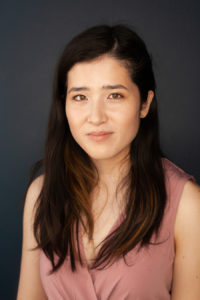
“[She] was like, ‘You know this is going to be a fight and you have to be ready for it,’” said Hsieh. “Then, like everyone else expressed, we released the statement and the emails came and then the meetings happened. And then the semester continued and things would happen and I would get all these phone calls. Someone would call me and say, ‘Did you hear what this professor said in this class?’ Or, ‘Did you hear about this whitewashing that happened in this casting?’ I would get calls where people would be crying or people would be angry and I’d be like, ‘Okay, this is a very different fight than what I thought it would be.’”
Carrying all of this had a measurable effect on organizers. Many felt as if the work of creating a more inclusive environment in their theatre departments became a second job—and an uncompensated one at that. Their individual experiences ranged from this work interfering with their schooling to its effects their mental health, even just general feelings of exhaustion. More than one organizer had to take a step back from this work at some point because of how overwhelming it became.
As Hsieh pointed out during the roundtable, “One statement is not going to end all of the systemic problems that exist out there.” This is true. Even programs that have begun to address the call-to-action letters still have a long way to go, and there are many changes these organizers would still like to see happen within their departments, including hiring more BIPOC instructors, something that was emphasized by all during the roundtable.
I must admit to my own initial wide-eyed fascination when these statements were being released last summer. As someone who is a Black alumni of a university theatre program, these letters carried a certain catharsis with them. I can guarantee that for every university theatre program that has yet to receive an official letter or statement, there are those that have been drafted in the minds of individual BIPOC students like myself—instances of racism being lamented among friend groups, itemized frustrations being written in the margins of notebooks, many ways, small or large, that students have broached the topic of racism within their program and been dismissed.
Whether university theatre programs across the board have seen significant shifts towards anti-racist practices within their departments isn’t for me or anyone else to say at this point. Each department is unique, and while the public nature of the release of these statements surely aided in holding these programs accountable, there were other statements—more than we may ever know about—released privately or sent directly to faculty and staff. Even at Syracuse, Green mentioned, last year’s statement from alumni organizers came a year after current Black students had already released their own letter to the university that went unnoticed.
What I can say is that anti-racism and EDI work that comes at the expense of the well-being of people of color only traded one problem for another. Don’t get me wrong: I believe BIPOC students and alumni should be centered in these conversations. But departments, and theatres in general, who choose to do this work now should be cautious about putting students and alumni of color in a position where they’re having to shoulder all of this labor, especially uncompensated. The onus is on white staff and faculty to do their part in this work so that their students can just be students—and alumni, and artists, and whatever else they’d like to be, without shouldering the burden of fixing decades of institutional racism. I wish I could end this article on a lighter note, but we’re still working on the initial ones.
Ciara Diane (she/her) is a New York-based freelance writer, performer, and playwright. She is a Sagittarius, intersectional feminist/womanist, Afrofuturist, and above all a storytelling experience.

